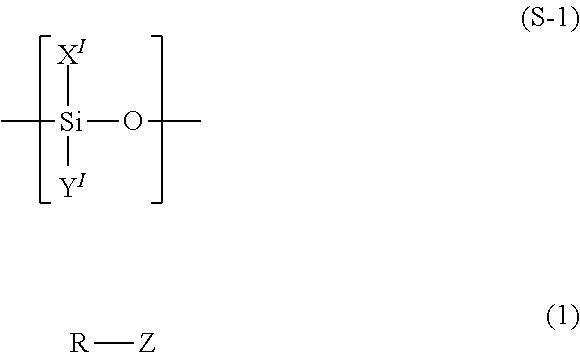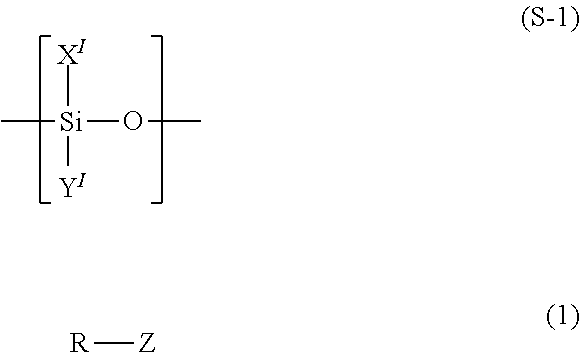Liquid crystal aligning agent, method of producing a liquid crystal alignment film and liquid crystal display device
a liquid crystal alignment and liquid crystal technology, applied in the direction of electric/magnetic/electromagnetic heating, instruments, transportation and packaging, etc., can solve the problems of unsatisfactory heat resistance and light resistance of conventionally accepted organic resins, and achieve excellent liquid crystal alignability, high heat resistance, and high storage stability
- Summary
- Abstract
- Description
- Claims
- Application Information
AI Technical Summary
Benefits of technology
Problems solved by technology
Method used
Image
Examples
synthesis example 1
[0236]100.0 g of 2-(3,4-epoxycyclohexyl)ethyl trimethoxysilane, 500 g of methyl isobutyl ketone and 10.0 g of triethylamine were fed to a reactor equipped with a stirrer, a thermometer, a dropping funnel and a reflux cooling tube and mixed together at room temperature. Thereafter, 100 g of deionized water was added dropwise to the resulting mixture from the dropping funnel over 30 minutes to carry out a reaction at 80° C. for 6 hours while it was mixed under reflux. After the end of the reaction, an organic layer was taken out and washed with a 0.2 wt % ammonium nitrate aqueous solution until water after washing became neutral, and the solvent and water were distilled off under reduced pressure to obtain a reactive polyorganosiloxane EPS-1 as a viscous transparent liquid.
[0237]When this reactive polyorganosiloxane EPS-1 was analyzed by 1H-NMR, a peak based on the oxiranyl group and having theoretical intensity was seen at around a chemical shift (δ) of 3.2 ppm. Thus, it was confirme...
synthesis examples 2 , 3 and 6 to 11
Synthesis Examples 2, 3 and 6 to 11
[0239]Reactive polyorganosiloxanes EPS-2, -3 and -6 to -10 were obtained as viscous transparent liquids in the same manner as in Synthesis Example 1 except that the charged raw materials were changed as shown in Table 1.
[0240]Mw's and epoxy equivalents of these reactive polyorganosiloxanes are shown in Table 1.
synthesis example 4
[0241]After 150 g of isopropanol, 5.4 g of a 10 wt % tetramethylammonium hydroxide aqueous solution (containing 5.93 mmol of tetramethylammonium hydroxide and 270 mmol of water) and 12 g of water were fed to a reactor equipped with a stirrer and a thermometer, 42.5 g (180 mmol) of γ-glycidoxypropyl trimethoxysilane was gradually added to the resulting mixture to carryout a reaction under agitation at room temperature for 20 hours.
[0242]After the end of the reaction, 200 g of toluene was added to the reaction mixture, and isopropanol was removed under reduced pressure. As for the residue, the reaction solution was washed in distilled water by using a separating funnel. After washing in distilled water was repeated until the water layer of the separating funnel became neutral, an organic layer was recovered and dehydrated with anhydrous sodium sulfate, and toluene was distilled off under reduced pressure to obtain a reactive polyorganosiloxane EPS-4.
[0243]The weight average molecular ...
PUM
| Property | Measurement | Unit |
|---|---|---|
| time | aaaaa | aaaaa |
| RI | aaaaa | aaaaa |
| RI | aaaaa | aaaaa |
Abstract
Description
Claims
Application Information
 Login to View More
Login to View More - R&D
- Intellectual Property
- Life Sciences
- Materials
- Tech Scout
- Unparalleled Data Quality
- Higher Quality Content
- 60% Fewer Hallucinations
Browse by: Latest US Patents, China's latest patents, Technical Efficacy Thesaurus, Application Domain, Technology Topic, Popular Technical Reports.
© 2025 PatSnap. All rights reserved.Legal|Privacy policy|Modern Slavery Act Transparency Statement|Sitemap|About US| Contact US: help@patsnap.com



